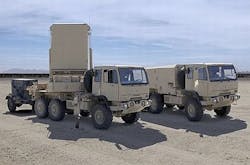Radar sensor fusion to protect Army base camps and improve counter-battery fire is thrust of Army RFI
ABERDEEN PROVING GROUND, Md., 17 May. 2012 U.S. Army researchers are reaching out to industry for fresh innovative ideas about radar sensor fusion and related technologies in support of the Army's Multi-function Radars for Integrated Area Defense (MyRIAD) project. MyRIAD seeks to use Army networks to enhance sensor coverage to protect Army base camps with to provide base camp protection and defense in several operating environments using existing, modified, and emerging radar systems.
The U.S. Army Communications-Electronics Research, Development, and Engineering Center (CERDEC) Intelligence and Information Warfare Directorate (I2WD) at Aberdeen Proving Ground, Md., issued a request for information Monday (RFI W15P7T12RA231) for the MyRIAD Common Operating Picture and Multi-Source Tracker initiative -- otherwise known as MyRIAD COP MST -- that asks industry for white papers on the best ways to implement radar sensor fusion with the radar systems the Army has now and will have in the near future.
Current Army radar systems are stove-piped and layer intelligence, surveillance, and reconnaissance (ISR) information inadequately to provide commanders with battle-space awareness, Army researchers say. The ideas is that by capitalizing on available networks, the Army can provide increased capability to the warfighter without increasing the number of deployed radar transceivers.
The MyRIAD COP MST project seeks to improve overall system of systems sensor performance by adapting each radar's coverage depending on available transceivers. In addition, MyRIAD will combine airborne and ground-based sensors to enhance situational awareness.
Key objectives include:
-- generating a common operating picture that blends counter-fire target acquisition (CTA), air surveillance (AS), and ground moving target indicator (GMTI) sensor data into one display;
-- using existing networks to consolidate planning for counter-fire radar systems;
-- using Army data networks to make the most of sensor coverage from radar systems operating in the same area, as well as to enable cross-cueing capability among radar installations; and
-- fusing data from several co-located CTA, AS, and GMTI radar systems to improve counter-fire weapons accuracy.
Army researchers want sensor-fusion proposals that involve non-proprietary, open standards, modular architecture, and scalable approaches.
Graphical user interfaces (GUIs) for track visualization should provide situational awareness and mission planning capabilities, and GUIs should be de-coupled from the fusion engine to provide maximum flexibility.
Industry responses to this RFI should describe detailed technical solutions, two-year cost estimates, license fees, any rationale for using non-standard interfaces, and cost, schedule, and technical risks.
Send responses no later than 18 June 2012 to by e-mail at [email protected], or by post to U.S. Army, RDECOM, CERDEC, I2WD, Bldg. 6005, APG, MD, 21005, ATTN: RDER-IWR-RS(MyRIAD).
For questions or concerns contact the Army's Stephen Winkler by phone at 410-417-0060, or by e-mail at [email protected].
More information is online at https://www.fbo.gov/notices/40f49f9ef04f60829af626dcb963bfb1.
Follow Military & Aerospace Electronics and Avionics Intelligence news updates on Twitter

